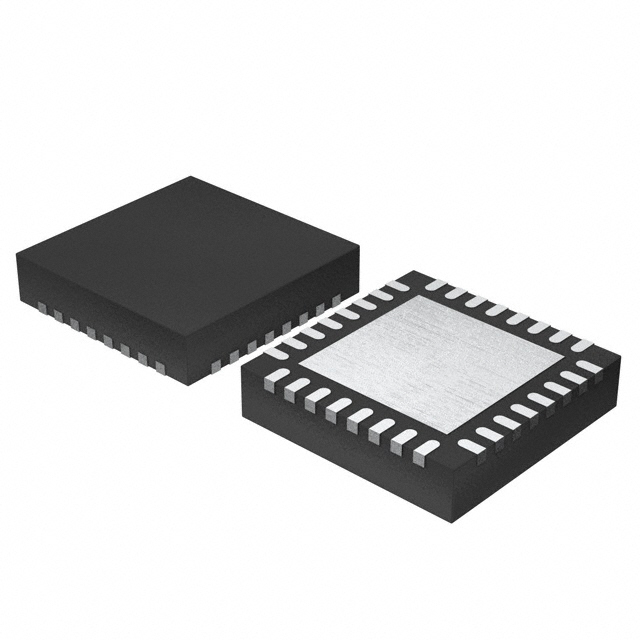LTC3892HUH#TRPBF
Product Overview
Category: Integrated Circuit (IC)
Use: Power Management
Characteristics: - High efficiency - Wide input voltage range - Adjustable output voltage - Current mode control - Synchronous rectification - Programmable soft-start - Overcurrent protection - Thermal shutdown
Package: 38-Lead Plastic QFN (5mm x 7mm)
Essence: The LTC3892HUH#TRPBF is a high-performance power management IC designed for various applications that require efficient and reliable power conversion.
Packaging/Quantity: The LTC3892HUH#TRPBF is available in a 38-lead plastic QFN package. The quantity per reel is typically 2500 units.
Specifications
- Input Voltage Range: 4.5V to 60V
- Output Voltage Range: 0.8V to 55V
- Maximum Continuous Output Current: 20A
- Switching Frequency Range: 100kHz to 1MHz
- Operating Temperature Range: -40°C to 125°C
Detailed Pin Configuration
The LTC3892HUH#TRPBF has the following pin configuration:
- VIN: Input voltage pin
- GND: Ground pin
- VCC: Supply voltage pin
- SS/TR: Soft-start/Tracking pin
- FB: Feedback pin
- SYNC: Synchronization pin
- PGND: Power ground pin
- SW: Switch node pin
- BST: Bootstrap pin
- EN/UVLO: Enable/Undervoltage lockout pin
- OCSET: Overcurrent limit set pin
- RT: Oscillator frequency setting pin
- AGND: Analog ground pin
- ITH: Current sense threshold pin
- VSENSE: Current sense input pin
- SS/TR2: Soft-start/Tracking 2 pin 17-38: NC (No Connection)
Functional Features
- High Efficiency: The LTC3892HUH#TRPBF utilizes advanced power management techniques to achieve high conversion efficiency, minimizing power losses.
- Wide Input Voltage Range: The IC can accept input voltages ranging from 4.5V to 60V, making it suitable for a wide range of applications.
- Adjustable Output Voltage: The output voltage can be easily adjusted within the range of 0.8V to 55V, providing flexibility in power supply design.
- Current Mode Control: The IC employs current mode control for improved stability and transient response.
- Synchronous Rectification: Synchronous rectification minimizes power dissipation and improves overall efficiency.
- Programmable Soft-Start: The soft-start feature allows for controlled startup, reducing inrush current and preventing voltage overshoot.
- Overcurrent Protection: The IC incorporates overcurrent protection to safeguard against excessive load currents.
- Thermal Shutdown: In case of excessive temperature, the thermal shutdown feature protects the IC from damage.
Advantages and Disadvantages
Advantages: - High efficiency power conversion - Wide input voltage range - Adjustable output voltage - Comprehensive protection features - Compact package size
Disadvantages: - Limited maximum continuous output current (20A) - Requires external components for operation
Working Principles
The LTC3892HUH#TRPBF operates as a step-down (buck) converter, converting a higher input voltage to a lower output voltage. It utilizes a synchronous rectification scheme to minimize power losses. The IC regulates the output voltage by adjusting the duty cycle of the internal switches based on the feedback signal. Current mode control ensures stable and responsive operation. The soft-start feature gradually ramps up the output voltage during startup, preventing excessive inrush current. Various protection features, such as overcurrent protection and thermal shutdown, ensure safe operation under different conditions.
Detailed Application Field Plans
The LTC3892HUH#TRPBF is suitable for a wide range of applications, including but not limited to: - Industrial power supplies - Telecom infrastructure - Automotive electronics - Distributed power systems - Battery-powered devices - LED lighting - Motor control systems
Detailed and Complete Alternative Models
- LTC3892IUH#TRPBF: Similar to LTC3892HUH#TRPBF, but with an extended operating temperature range (-40°C to 150°C).
- LTC3892EUF#TRPBF: Similar to LTC3892HUH#TRPBF, but in a smaller 38-Lead QFN package (4mm x 6mm).
- LTC3892MPM#PBF: Similar to LTC3892HUH#TRPBF, but in a 64-Lead LQFP package,
Lista 10 Vanliga frågor och svar relaterade till tillämpningen av LTC3892HUH#TRPBF i tekniska lösningar
Sure! Here are 10 common questions and answers related to the application of LTC3892HUH#TRPBF in technical solutions:
Q: What is LTC3892HUH#TRPBF? A: LTC3892HUH#TRPBF is a high-performance synchronous step-down DC/DC controller IC manufactured by Linear Technology (now part of Analog Devices). It is commonly used in power management applications.
Q: What is the input voltage range supported by LTC3892HUH#TRPBF? A: LTC3892HUH#TRPBF supports an input voltage range from 4.5V to 60V, making it suitable for a wide range of applications.
Q: What is the output voltage range that can be achieved with LTC3892HUH#TRPBF? A: The output voltage range of LTC3892HUH#TRPBF depends on the external components used in the circuit design. It can support output voltages as low as 0.8V.
Q: What is the maximum output current that LTC3892HUH#TRPBF can handle? A: LTC3892HUH#TRPBF can handle a maximum output current of up to 20A, making it suitable for high-power applications.
Q: Does LTC3892HUH#TRPBF have built-in protection features? A: Yes, LTC3892HUH#TRPBF includes various protection features such as overvoltage protection (OVP), overcurrent protection (OCP), and thermal shutdown.
Q: Can LTC3892HUH#TRPBF operate in a synchronous or non-synchronous mode? A: LTC3892HUH#TRPBF can operate in both synchronous and non-synchronous mode, providing flexibility in different application scenarios.
Q: What is the switching frequency range of LTC3892HUH#TRPBF? A: The switching frequency of LTC3892HUH#TRPBF can be programmed from 100kHz to 1MHz, allowing optimization for efficiency or size.
Q: Is LTC3892HUH#TRPBF suitable for automotive applications? A: Yes, LTC3892HUH#TRPBF is designed to meet the requirements of automotive applications and is qualified for operation in automotive environments.
Q: Can LTC3892HUH#TRPBF be used in battery-powered systems? A: Yes, LTC3892HUH#TRPBF can be used in battery-powered systems as it supports a wide input voltage range and has low quiescent current.
Q: Are there any evaluation boards or reference designs available for LTC3892HUH#TRPBF? A: Yes, Analog Devices provides evaluation boards and reference designs for LTC3892HUH#TRPBF, which can help users quickly prototype and implement their power management solutions.
Please note that the answers provided here are general and may vary depending on specific application requirements. It is always recommended to refer to the datasheet and application notes provided by the manufacturer for detailed information.


